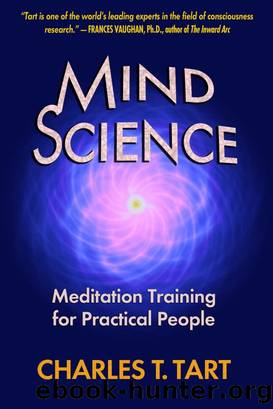Mind Science by Charles T. Tart

Author:Charles T. Tart
Language: eng
Format: epub
Tags: consciousness, science, meditation, zen, mental clarity
Publisher: D. Patrick Miller
Here is the mind, represented on the left in all three phases of the diagram. Here is the external world, on the right. When something happens, you're stimulated and your attention goes out. For example, you hear a loud bang, or somebody says hello, or the phone rings. In ordinary consciousness the bulk of your attention goes out, indicated by the thick arrow. This is "normal," it's semi-voluntary in terms of control, it's semi-automatic attention.
Then, as the middle part of the diagram shows, our automatic habits are such that almost all of our attention might well be grabbed up by internal reactions to the external stimulus. Somebody says hello, you automatically say hello. You don’t have to think about it. A loud bang and you're all wound up in fear and wondering, "Are they shooting at me?" And so forth. An apperceptive mass of mental, emotional and bodily habits is aroused by the stimulus and pretty much all your attention and energy is used up by these reactions in "normal" consciousness.
But a third style is possible, shown in the bottom third of Figure 1. Gurdjieff’s primary technique for being more present, for self-remembering, is to deliberately split the arrow of attention, so that no matter what happens, you never allow all your attention to be taken by anything, be it external stimulus or internal reaction. A small amount of it is always kept in the role of observer. A small amount always goes to the "laboratory," where the inner scientist is, as it were, taking notes on what is happening specifically, this instant, then this next instant, and then this next instant, ad infinitum.
This deliberate split of attention can make major changes in the way you live your life. Instead of events grabbing all of your energy and then starting all the automatic psychological machinery — you know, whenever somebody looks at me that way I get such and such a kind of reaction — instead of that kind of thing mechanically and automatically happening, a new quality of experience results, which I like to term spaciousness. Instead of life being quite so pressed, with one reaction and action and reaction and action, etc., etc., one right after another, there is a little bit of space experienced around events. You have more time to understand them in a relaxed, holistic way, and have moments to consider what you’re doing or starting to do.
I’ve begun describing this effect as spaciousness only lately; I wouldn’t have been able to do that even a few years ago. Years ago I took several courses on meditation from a Tibetan lama, Tarthang Tulku, at the Nyingma Institute in Berkeley. One of the things he talked about in many lectures that really intrigued me was "finding the space between thoughts." I found that a fascinating concept and I thought about it a great deal but I never found any space between my thoughts! It was a great hypothesis, this space between thoughts, but my thoughts were "Zoom-zoom-zoom-.
Download
This site does not store any files on its server. We only index and link to content provided by other sites. Please contact the content providers to delete copyright contents if any and email us, we'll remove relevant links or contents immediately.
| ESP | Near-Death Experiences |
| Out-of-Body Experiences |
Animal Frequency by Melissa Alvarez(3754)
Sigil Witchery by Laura Tempest Zakroff(3651)
Real Magic by Dean Radin PhD(3567)
Fingerprints of the Gods by Graham Hancock(3211)
The Rosicrucians by Christopher McIntosh(3049)
Aleister Crowley: The Biography by Tobias Churton(3019)
Journeys Out of the Body by Robert Monroe(2984)
Alchemy and Alchemists by C. J. S. Thompson(2911)
Mysteries by Colin Wilson(2885)
Hitler's Monsters by Eric Kurlander(2731)
John Dee and the Empire of Angels by Jason Louv(2709)
Wicca: a guide for the solitary practitioner by Scott Cunningham(2704)
Infinite Energy Technologies by Finley Eversole(2492)
The Hatha Yoga Pradipika (Translated) by Svatmarama(2481)
Dark Star Rising by Gary Lachman(2419)
Aliens by Jim Al-Khalili(2382)
The Book of Lies by Aleister Crowley(2382)
To Light a Sacred Flame by Silver RavenWolf(2353)
Hitler's Flying Saucers: A Guide to German Flying Discs of the Second World War by Stevens Henry(2293)
